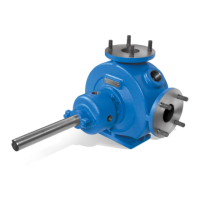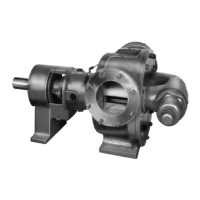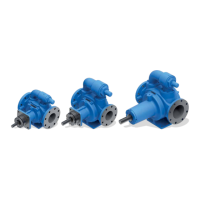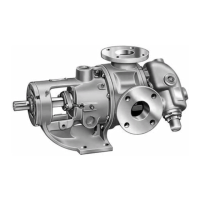
Do you have a question about the Viking pump 34 Series and is the answer not in the manual?
| Pump Series | 34 Series |
|---|---|
| Materials | Cast Iron, Stainless Steel |
| Seal Options | Mechanical Seals, Packing |
| Drive Options | Belt Drive, Gear Drive, Direct Drive |
| Applications | Chemicals, Food |
Ensures safe procedures when opening pump liquid chambers, including pressure venting and lockout.
Ensures drive guards are in place before operating the pump to prevent injury.
Caution against operating the pump without connected suction or discharge piping.
Warns against placing body parts into pump or drive train when shafts may rotate.
Advises against exceeding pump's rated pressure, speed, and temperature without verification.
Lists essential checks before operating the pump, including cleanliness, valve status, and alignment.
Recommends caution and proper devices for lifting pumps, using lifting eyes or base plates.
Warns against dismantling a pressure relief valve without relieving spring pressure.
Advises avoiding contact with hot pump or drive surfaces due to operating conditions.
Mandates pressure protection for pumps, such as relief valves, and notes reverse rotation considerations.
Requires pump installation to allow safe access for routine maintenance and inspection.
External lubrication every 500 hours with multi-purpose grease; consider temperature for other needs.
Details initial packing adjustment, occasional inspection, and eventual replacement needs.
Explains how to adjust end clearance to improve pump performance after long-term operation.
Recommends keeping the pump clean to facilitate inspection, adjustment, and repair work.
Outlines draining, lubricating, and preserving parts when storing the pump, and draining jackets.
Lists essential tools required for repairing Series 34 and 434 pumps.
Crucial safety steps before opening any liquid chamber during disassembly, including pressure venting and lockout.
Notes on marking heads/casings and positioning the idler pin for correct reassembly.
Procedure for cooling the pump and removing the head, noting relief valve status.
Instruction to remove flush lines from mechanical seals before proceeding.
Warning to prevent the idler from falling off the idler pin during head removal.
Steps to adjust setting clips and loosen set screws for mechanical seals.
Procedure for removing nuts, washers, and lockwashers to slide off the mechanical seal assembly.
Instructions for carefully removing the rotor and shaft from the pump.
Warning to avoid damaging the rotor bearing sleeve bushing during disassembly.
Instructions for assembling thrust washers on rotor hub and bearing sleeve for Q, M, N sizes.
Procedure for assembling the rotor and shaft in the casing, ensuring proper lubrication.
Provides a table showing gasket amounts needed for proper end clearance in different pump models.
Guidance on lubricating and assembling the idler and bushing onto the idler pin.
Details on packing pumps, cutting rings, staggering joints, and seating packing.
Steps for installing mechanical seals, including shaft preparation, tightening nuts, and setting clips.
Procedure for PSII seals, including tab rotation, sleeve spacing, and securing nuts.
Important notes for mechanical seal startup, preheating, steam quench, and double seal procedures.
Considerations when converting to a mechanical seal, including shaft condition and alignment.
Emphasizes proper sheave alignment and shaft support for V-belt driven asphalt pumps.
Illustrates plain and jacketed relief valves with a list of parts for ordering.



